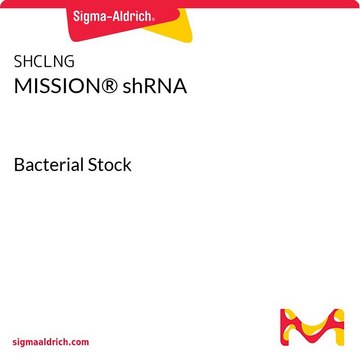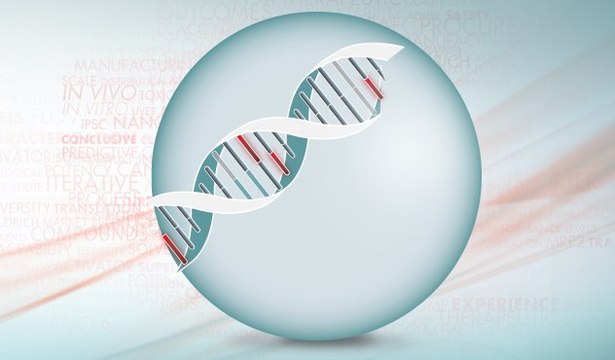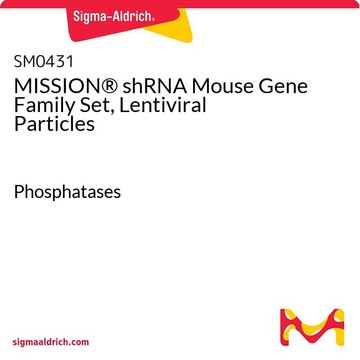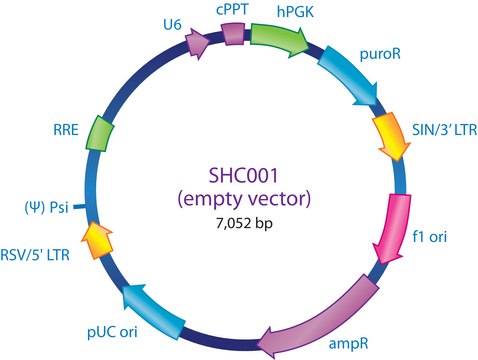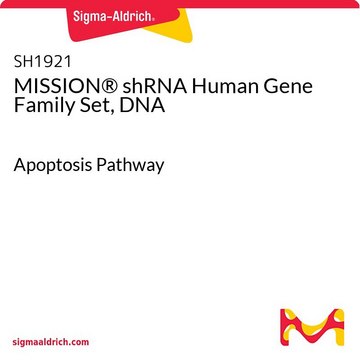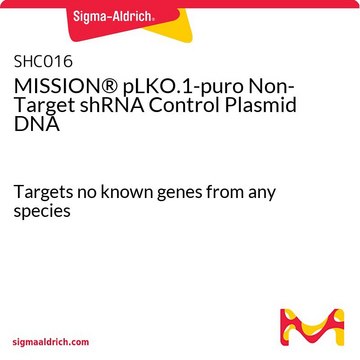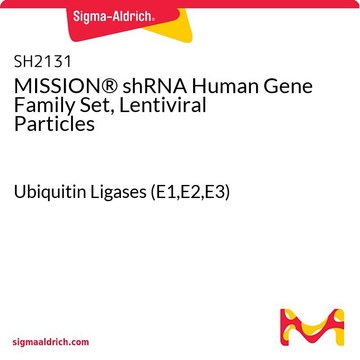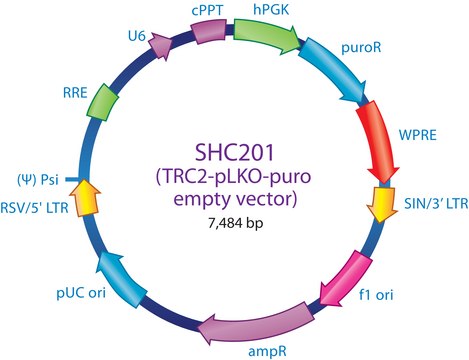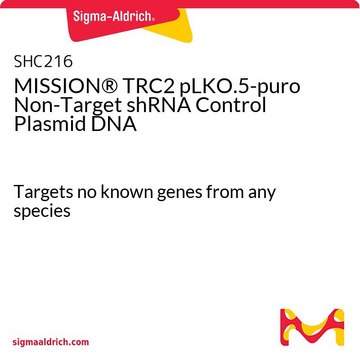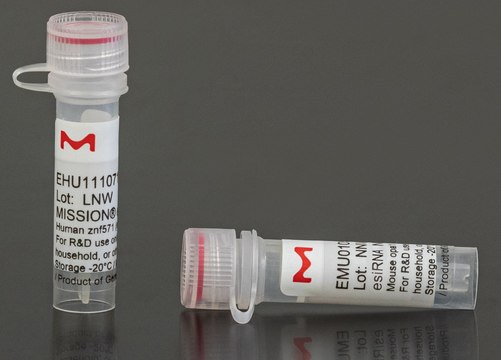Key Documents
Safety Information
SH0531
MISSION® shRNA Human Gene Family Set, Lentiviral Particles
Tumor Suppressors
Select a Size
Select a Size
About This Item
Recommended Products
Looking for similar products? Visit Product Comparison Guide
1 of 4
This Item | EMU072451 | EMU085071 | EMU069331 |
|---|---|---|---|
| esiRNA cDNA target sequence TCATTCTCTTACAACCACCTTCCATATACCTTCAAGTCAACATTACCAAGAAGAGCATTCACCATCATTGTCAGGATCAGATTCTCTTCTTCAAATAACCACTCCTGTGGTGGCTTCAACTGTAGGTAACCCAAATCAGCATTCAGCAACAATGTCAACACCAGCTATTCATGTCTCAACTTATCACACGGCCCCTACTGAAGTGTCTGCTGCGTTTGAAGAACAGCCTGTCTCACCACACATTGGAGGAATGCCGTCACCAATTCAACACGATTTTCCTGCACTAGTGATGATACTCATAATTTTGGGCGTGATGGCAGGGATTATCGGAACTATCCTTCTTATCTCTTACTGTATCAGCCGAATGACAAAGAAAAGTTCAGTTGACATCCAATCTCCTGAGGGTGGTGACAACAGTGTGCCTTTGAGTTCTATTGAGCAGACTCCTAATGAAGAGTCCTCCAATGTTTGAAAGACCTCAAGGAAAACAAGACTTCAATCAATGGGAAA | esiRNA cDNA target sequence GGGCAGGTTGAGTTCATTGTAAATAATTGTGTAAATCACTGTTCTAGTAATTTAAAAATAACATTAATTTTTCTACAAAATGCGAGATTTATAAATGTTTGAAATTGTACCTATTGATAATTAATGGTAAGTTTACTTAAAATAAATGTATCCCTTATTTCTTATCTGCATTTCTCATTTCCAGATGAAAGTTTAGTTATCAGAGATGTTTCAGCACACACAAAAGCCACTTTTCAGTACTTGTTCACATGCACTGACGAGCTAATTAGCAGCAGAAGTGGTTTCTGGAATGATGAACACCTTAATCATTCTGTTAGAACAGATTAGACAGTTCCTACCTCAGCATTTTCAGAAAACACACTTTCAAGGCCAAAAGCCATCATCATCAGTAGAGTCTCCCCTTGCTGAGACCTAATTATCTCCGGGGTTCCATC | esiRNA cDNA target sequence TGACAGCGAAGGCAATGTAGTGAACAAACCCGACAGCCATGGTGGCAGCCTCGAATGGACAAAGATCTGTGAGAAGTCCTCTAAAGTGATCACCTTCATCGACTTGGCTGGCCACGAGAAGTACCTTAAGACCACTGTTTTTGGCATGACTGGCCACTTGCCTGACTTCTGCATGCTCATGGTGGGCAGCAATGCTGGCATTGTGGGGATGACCAAGGAGCATCTGGGCTTGGCATTGGCACTCAATGTACCTGTGTTTGTGGTTGTCACCAAGATTGACATGTGTCCTGCCAACATCCTTCAAGAAACCCTGAAGCTGCTACAGCGCCTGCTGAAGTCACCAGGCTGCCGGAAGATCCCTGTCCTGGTGCAGAGCAAAGATGATGTGATTGTCACAGCCTCCAACTTCAGCTCTGAGAGGATGTGCCCGATATTCCAGATCTCCAATGTCACAGGTGAGAACCTTGACCTGCTCAAGATGTTCCTCAACCTCCTGTCC | esiRNA cDNA target sequence CACCAGTTTCGGACCAGTTTCAGACCACGATATGGAGTATACAATAGATGTGTTTTTCCGTCAAAGTTGGAAGGATGAAAGATTAAAATTCAAAGGACCCATGACAGTGCTCCGGCTAAACAACCTTATGGCCAGTAAAATCTGGACTCCAGATACATTTTTCCACAATGGAAAGAAGTCTGTGGCCCACAACATGACCATGCCTAATAAGCTCCTGCGTATCACAGAGGATGGCACTCTGCTGTACACCATGAGGTTGACCGTGAGAGCTGAATGCCCAATGCACTTGGAAGACTTCCCTATGGATGCCCATGCCTGCCCACTAAAATTCGGAAGCTATGCTTATACAAGAGCAGAAGTTGTCTATGAGTGGACCAGAGAGCCAGCCCGTTCAGTGGTTGTAGCAGAAGATGGGTCACGTTT |
| product line MISSION® | product line MISSION® | product line MISSION® | product line MISSION® |
| Ensembl | mouse accession no. | Ensembl | mouse accession no. | Ensembl | mouse accession no. | Ensembl | mouse accession no. |
| Gene Information mouse ... GYPA(14934), Gypa(14934) | Gene Information mouse ... GYK(14933), Gyk(14933) | Gene Information mouse ... GTPBP1(14904), Gtpbp1(14904) | Gene Information mouse ... GABRA1(14394), Gabra1(14394) |
| form lyophilized powder | form lyophilized powder | form lyophilized powder | form lyophilized powder |
| storage temp. −20°C | storage temp. −20°C | storage temp. −20°C | storage temp. −20°C |
General description
Application
Other Notes
Legal Information
Storage Class Code
12 - Non Combustible Liquids
WGK
WGK 3
Flash Point(F)
Not applicable
Flash Point(C)
Not applicable
Personal Protective Equipment
Regulatory Information
Choose from one of the most recent versions:
Certificates of Analysis (COA)
It looks like we've run into a problem, but you can still download Certificates of Analysis from our Documents section.
If you need assistance, please contact Customer Support.
Already Own This Product?
Find documentation for the products that you have recently purchased in the Document Library.
Our team of scientists has experience in all areas of research including Life Science, Material Science, Chemical Synthesis, Chromatography, Analytical and many others.
Contact Technical Service